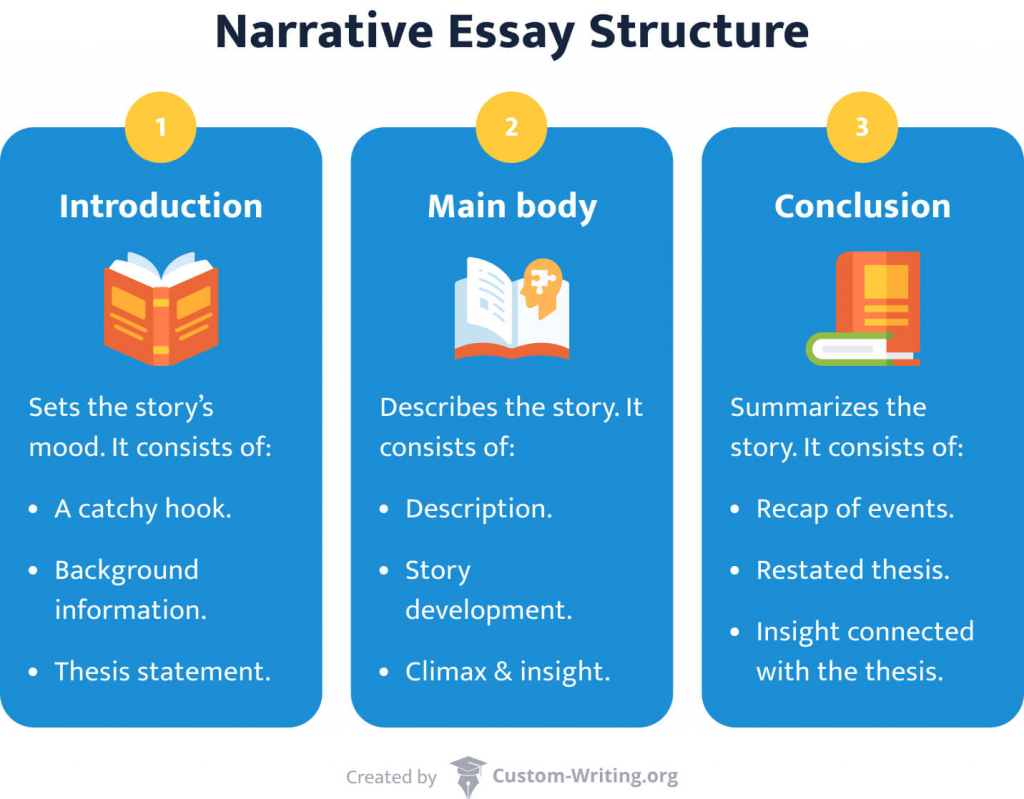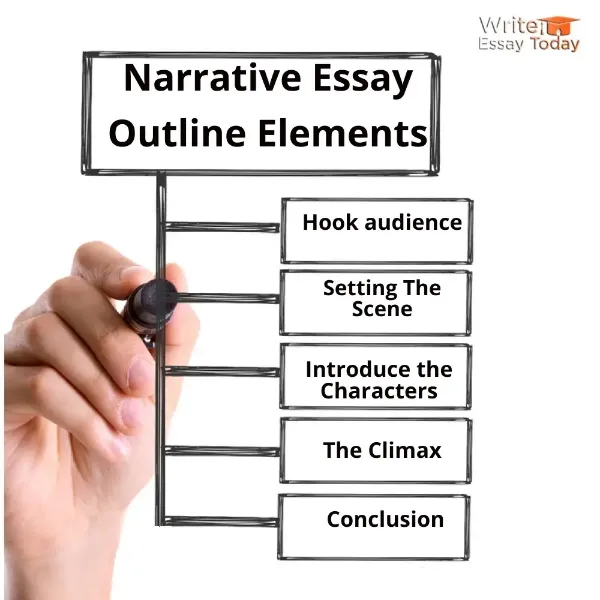How to Write a Narrative Essay Outline: Template & Examples
Narrative essays are unlike anything you wrote throughout your academic career. Instead of writing a formal paper, you need to tell a story. Familiar elements such as evidence and arguments are replaced with exposition and character development.
The importance of writing an outline for an essay like this is hard to overestimate. This article by Custom-Writing.org will give you a helping hand with that. Here, you will find:
- The definition of a narrative essay.
- Helpful tips for creating a narrative essay outline.
- A printable example template in PDF format.

📚 What Is a Narrative Essay?
- Introduction
📝 Narrative Essay Outline Template
❓ narrative essay outline, 🔍 references.
A narrative essay is presented in the form of a story. It has the same goal as any other academic work: to prove a certain point. But it is very different from a regular paper. The main dissimilarities are the following:
- A narrative essay doesn’t contain any arguments in the usual sense. Instead, you use the text’s plot to illustrate your point.
- It has several unique elements. Aside from the usual parts such as the introduction and thesis, your story also needs characters, dialogs, a climax, and more.
- It’s creative in essence. Typically, you need to keep things formal and grounded in your essays. A narrative essay is an exception. While writing it, your inner artist is free to run wild. Vivid imagery and descriptive language will only make your essay more effective.
Another interesting thing that you are not necessarily bound to a single story. You can tell several accounts in one essay and connect them to a unifying thesis.
Now that you know what sort of assignment you’re dealing with, you can start developing your outline.
✍️ How to Write a Narrative Essay Outline
First, you should understand what type of narrative you want to create. There are 2 options you can pick from:
- Personal experience. It’s simpler to write about since you don’t have to come up with anything new. You only need to describe an account about yourself or about someone else that actually happened.
- A piece of fiction. This option is a bit trickier in comparison. It requires you to think up a whole story. Nevertheless, the results will likely be more satisfying.
Once you’ve decided on the type of narrative, you need to determine what sort of outline you want. It can be straightforward and minimalist with the essential elements only. Or, you can make it as comprehensive as you wish. It’s helpful to remember that a narrative essay is usually 5 paragraphs long: make sure not to go overboard or make it too laconic.
Now, let’s talk about the structure of your narrative paper’s individual parts.

Narrative Essay Introduction
Your introduction won’t be that different from that of a regular essay. You need 3 things here:
- A hook to captivate the readers’ attention;
- Some background information pertinent to your story;
- A thesis statement introducing your essay’s main point.
How to Start a Narrative Essay
First and foremost, your essay needs a catchy hook. It’s a captivating sentence that aims to grab the reader’s attention. While a piece of statistics or an interesting fact can serve as a good hook for an average paper, it’s too plain for a narrative essay. So, we need to go a bit more creative.
Say you are writing an essay about the influence of music on a person’s views. The core of your essay is a story of you visiting your first classical concert. One option is to start with a question. Asking something immediately evokes the need to answer. It also stimulates interest along the way.
Furthermore, questions make the transition into the background info easy and smooth. Just answer the hook question:
Hook: Do you remember going to your first concert?
Background: I sure do. It was a magnificent evening on the first weekend of spring. The only thing I was skeptical about was the concert itself. I was not the greatest fan of classical music; rather, I was not too fond of those who enjoy it. I thought of them as arrogant and selfish.
Make sure not to start telling about the events of your story in the introduction. Instead, you can tell what preceded it or just set the mood. If you’re looking for more ideas on how to start an essay, be sure to check out our article on hooks in writing .
Narrative Essay Thesis Statement
The thesis statement of a narrative essay answers the question, “What am I trying to say with this story?” It conveys the main idea and can be formulated in various ways. It can be your regular thesis with the main point and arguments. But don’t forget that you are writing a story. This means you can make your thesis a part of the narrative; build it as a starting point of your account or showcase the lesson you’re about to learn.
Have a look at these narrative essay thesis examples to get a better idea:
If only I knew the power music holds and how it can dramatically change one’s perception of things.
I didn’t know yet that this event would change how I saw classical music and its fans.
You might want to formulate the thesis and put it into your outline before everything else. This way, it will be easier to write your story around it.
Narrative Essay Body Paragraphs
After you’re done with the thesis, you can continue your story and prove the main argument. There are 2 ways to go about your essay’s body paragraphs:
Option 1: Make each paragraph into an individual story.
✔️ Pros: This structure allows you to use several arguments related to different storylines.
❌ Cons: In this case, you’ll need to structure your essay’s body densely in order not to make it too long.
Option 2: Use the whole essay’s body to tell a single story.
✔️ Pros: This way, it’s easier to structure the body of your essay.
❌ Cons: Since you are limited by a single story, your argumentation becomes weaker.
Whichever way you choose, you need to remember the general storytelling rules:
- Describe things in chronological order. Make sure that the events of your story follow each other coherently.
- Don’t break the general “introduction-development-conclusion” structure . As long as your narrative has these 3 elements, you will have a decent story.
Here’s what you can write about in your narrative essay’s body paragraphs:
- It’s always a good idea to start with a description of things . It creates necessary immersion and makes the reader more involved with the story.
- You can also dedicate the first paragraph to setting up the characters of your story (if there are any.)
- The following two paragraphs are about developing, culminating, and ending your story.
In the case of a classical concert, an average body outline sample can look like this:
Paragraph 1
Here, you begin your story and describe the concert hall and the people inside it.
Paragraph 2
Now, you develop the story. For example, mention your friend whom you didn’t expect to see at such an event.
Paragraph 3
In this paragraph, you can culminate your story with an insight that demonstrates a more profound realization of the idea in your thesis. For instance, your friend is very humble and grounded. However, he is a big fan of classical music. You realize that your prejudice towards classical music fans is wrong.
Narrative Essay Conclusion
The conclusion of your story summarizes the body of your essay. It also restates your thesis in a paraphrased form. Make sure not to add any new info to your outline at this stage. The conclusion is only there to sum things up and draw attention to the most important points.
In a narrative essay conclusion, it’s a good idea to mention the insight and demonstrate its connection to the thesis. In the case of our classical music essay, it could look like this:
This is the story of my epiphany on the connection between music and personality. Judging people by their music taste turned out to be a gigantic mistake. But I am happy to have made this misstep since it helped me learn an important lesson.
Now, let’s see what we have in the end. Have a look at the following narrative essay outline example:
- Hook. It’s a catchy and intriguing sentence. An interesting question or a surprising fact will do.
- Background information. This means everything the reader needs to know before diving into the main part.
- Thesis statement. It can be a generic thesis or a poetic sentence that demonstrates your point.
- Description paragraph. It’s a paragraph that helps the reader visualize your story. You can also introduce the characters here.
- Story development paragraph. This is the part where you develop the established characters and storyline.
- Story climax and end paragraph. It’s a part that contains the highest point of your narrative and its logical end.
- Summary. Briefly conclude the events described in your body paragraphs.
- Restated thesis. Paraphrase your main claim and provide a deeper understanding of the insight.
You can download a 5-paragraph narrative essay template in PDF format using the link below. It can be very helpful for outlining your essay: simply print it out and fill in the blanks.
- Your essay’s title.
- Start with a catchy and intriguing sentence.
- Provide some background information about the topic.
- Write a strong thesis statement that demonstrates your point.
We’ve also gathered some narrative essay examples for you to gain inspiration. Check them out below!
- Literacy Narrative: “Make a Wish”
- Multimodal Personal Narrative: The Path to the Goal
- Clinical Narrative: Conversation With a 30-Years-Old Woman With Diabetes
Literacy Narrative Outline Template
A literacy narrative is a story that chronicles your experience of developing a particular skill. Usually, it refers to learning to read and write. The thing is to underline the importance of the described accomplishment.
- Hook sentence. As an attention-getter, you might use an interesting tidbit about yourself.
- Background information. Offer a brief description of the skill’s role in your life.
- Thesis statement. Compose a sentence stressing the importance of the skill you acquired. Use the thesis to show how your experiences have changed after learning it.
- Description. Depict your life before discovering the skill in question.
- Story development. In the second body paragraph, concentrate on the learning process itself.
- Story climax and end. Now, you can close the story with your triumph. You can also compare “before” and “after.”
- Summary. Briefly retell the story of learning the skill.
- Restated thesis. Remind the reader why the subject holds a personal meaning for you.
Feel free to download this template in PDF format using the link below.
- Provide some background information about the skill you’ve learned.
- Write a thesis statement that demonstrates the importance of the skill you’ve learned.
Narrative Essay Topics
- My experience of learning English
- My first time riding a bicycle
- A defining event from my childhood
- My personal methods of handling stress at high school
- My experience with attending the logic course
- My experience with writing
- A personal experience of mysophobia
- Experiencing mystical events
- Lesson learned in college as a nursing student
- The impact of the English writing course on my academic success
- What has working in Walmart taught me?
- The importance of college experience for a career in healthcare
- Virtual concert impression
- Lincoln Center Orchestra’s online concert experience
- My opinion on Simmers restaurant service
- My favorite form of literature
- My experience of working with children with autism
- My memories of the first day in college
- College as the first step of my professional development
- College experience as a nursing student
- What my first semester has taught me
- The most memorable childhood holiday
- My most memorable college teacher
- The first time I attended a rock concert
- My impression of piano music concert
- My expatriation experience
- What I’ve learned during my practicum
- Life of people of different races and age groups in the USA
- My personal financial plan
- My experience with attending court
- What I’ve learned working with catheter-related bloodstream infections
- S. Kruzan and C. Brown’s case in criminal justice system
- How my Senior Developer position contributed to my professional development
- The effect of the authoritative parenting style on my life
- My first job experience
- What I’ve learned working as a researcher in the company
- My personal experience and Erikson’s theory of development
- Hardships and benefits of a study group
- How I challenged gender norms
- The time when I was working as a head nurse
- The influence of Italian culture on me
- How I bought my laptop and the salesperson’s impact on my experience
- What I have learned during my trip to the Museum of Western Heritage
- How I spent a day without my cellphone
- Skills I’ve acquired during my practicum experience in New York Methodist Hospital
- My impression of visiting the Energy Medicine Florida
- The time I visited Yellowstone National Park
In conclusion, we would like to wish you good luck with your assignment! Make sure to comment on the things you’ve found the most useful.
Further reading:
- How to Write a Good Narrative Essay: Tips, Examples, & Step-by-Step Guide
- What Are the 5 Different Types of Essays? A Complete Guide
- How to Write a Creative Essay: Tips, Topics, and Techniques
- How to Write a Personal Essay: Topics, Structure, & Examples
How Do You Write a Narrative Essay Step by Step?
- Choose a topic for your essay.
- Decide on the type of your story (either personal or fictional.)
- Write an outline. Make sure to come up with the thesis first.
- Write your essay.
What Is the Purpose of Dialogue in a Narrative Essay?
The purpose of any dialog is to demonstrate a conversation between people. Showing your characters having a conversation can help you develop them. You can also use dialogues to advance your story.
What Are the 4 Ways You Can Start a Narrative Essay?
Some possible starters for your essay are:
- Asking the reader a question.
- Opening up with a joke.
- Revealing shocking information about the events described further.
- Telling your readers an interesting fact about the topic of your essay.
- Narrative Essays: Purdue Writing Lab
- How to Write a Narrative Essay: Writers.com
- Narrative Essay: Nova Southeastern University
- Narrative Essay: Excelsior College
- Narrative Essay: Miami University
- Unique Characteristics of Narrative Essays: Oklahoma State University
- Descriptive Narrative Essay: Southeastern Louisiana University
- Narrative Essay Writing Prompts: California State University Stanislaus
- Share to Facebook
- Share to LinkedIn
- Share to email

Discourse is the way people talk about any specific topic. It’s also the way in which language is used to convey social and historical meanings. Discourse analysis is the process that helps to understand the underlying message of what is being said. Sounds interesting? Keep reading to learn more. This in...

A précis is a brief synopsis of a written piece. It is used to summarize and analyze a text’s main points. If you need to write a précis for a research paper or the AP Lang exam, you’ve come to the right place. In this comprehensive guide by Custom-Writing.org, you’ll...

A synthesis essay requires you to work with multiple sources. You combine the information gathered from them to present a well-rounded argument on a topic. Are you looking for the ultimate guide on synthesis essay writing? You’ve come to the right place! In this guide by our custom writing team,...

A critical analysis essay is an academic paper that requires a thorough examination of theoretical concepts and ideas. It includes a comparison of facts, differentiation between evidence and argument, and identification of biases. Crafting a good paper can be a daunting experience, but it will be much easier if you...

Critical thinking is the process of evaluating and analyzing information. People who use it in everyday life are open to different opinions. They rely on reason and logic when making conclusions about certain issues. A critical thinking essay shows how your thoughts change as you research your topic. This type...

Process analysis is an explanation of how something works or happens. Want to know more? Read the following article prepared by our custom writing specialists and learn about: So, let’s start digging deeper into this topic! ♻️ What Is Process Analysis? A process analysis describes and explains the succession of...

A visual analysis essay is an academic paper type that history and art students often deal with. It consists of a detailed description of an image or object. It can also include an interpretation or an argument that is supported by visual evidence. In this article, our custom writing experts...

Want to know how to write a reflection paper for college or school? To do that, you need to connect your personal experiences with theoretical knowledge. Usually, students are asked to reflect on a documentary, a text, or their experience. Sometimes one needs to write a paper about a lesson...

A character analysis is an examination of the personalities and actions of protagonists and antagonists that make up a story. It discusses their role in the story, evaluates their traits, and looks at their conflicts and experiences. You might need to write this assignment in school or college. Like any...
![how to do a narrative essay outline Critical Writing: Examples & Brilliant Tips [2024]](https://custom-writing.org/blog/wp-content/uploads/2021/02/fingers-note-report-journalist-filling-284x153.jpg)
Any critique is nothing more than critical analysis, and the word “analysis” does not have a negative meaning. Critical writing relies on objective evaluations of or a response to an author’s creation. As such, they can be either positive or negative, as the work deserves. To write a critique, you...

If you are assigned to write a rhetorical analysis essay, you have one significant advantage. You can choose a text from an almost infinite number of resources. The most important thing is that you analyze the statement addressed to an audience. The task of a rhetorical analysis essay is to...

Any literary analysis is a challenging task since literature includes many elements that can be interpreted differently. However, a stylistic analysis of all the figurative language the poets use may seem even harder. You may never realize what the author actually meant and how to comment on it! While analyzing...
New here? Signup with us
Already have an account? Login with us
- Have any questions?
- 866-388-7579 (Toll Free)
- 786-697-1078 (Text/Call)
- [email protected]
Detailed Guide on How to Write a Narrative Essay Outline with Tips
- Post on October 21, 2023
- By Oliver Jack
Are you interested in taking your audience on a journey through your storytelling? Or perhaps you've been assigned a narrative essay and aren't quite sure where to begin? Crafting a compelling narrative essay outline is the key to unlocking your storytelling potential. This blog by WriteEssayToday explains how to create a narrative essay outline , including helpful advice and a real-world example. Here you'll discover:
What is a Narrative Essay?
- What Should You Do Before Writing Your Outline?
- How To Structure Your Outline Of Narrative Essay
Tips For A Flawless Narrative Essay Outline
- Narrative Essay Outline Example And Template
Together, let's create a narrative outline that has a lasting impact
A narrative essay is a brief story with a revolving central idea. You can explore emotions, share personal experiences, and demonstrate your storytelling skills. But how do you get started? Crafting a stellar narrative essay outline is the key to ensuring your narrative flows seamlessly.
What Makes a Narrative Essay Unique
Storytelling is unique, in all forms of presentation. They provide a forum for exchanging insights, tales, and emotions. Unlike informative writing, narrative aims to engage readers in the author’s world. These stories establish a close connection with the viewer by using a first-person point of view and adopting a voice.
What do you need to do before writing your outline?
Before you start planning your story, it’s important to complete a few important steps that will prepare the ground for it. These early actions include:
- Think about memorable experiences.
- Consider the mood and characters.
- Develop character personality and quirks.
- Imagine and describe vivid situations.
- Communicate the emotions involved.
- Plan the structure of your story.
- Gather the right things.
- Prioritize fat writing before perfection.
What Makes a Good Narrative Outline? & How to Structure One
Consider your narrative essay outline as the blueprint for your masterpiece. It ensures your story develops logically and keeps your readers interested from beginning to end. Let's get into the elements of a well-crafted narrative essay outline:

1. Hook Your Audience
This is the first step and perhaps most important one. The introduction is your chance to grab your reader's attention. Engage their curiosity with a captivating hook. You can use a quote, a question, or even a startling fact. Make sure your introduction sets the stage for the story you're about to tell.
2. Setting the Scene – Where and When
Make a background for your story in this section. Talk about a crowded metropolis, a sandy beach, or a dark wilderness. Your readers will experience being present with you. Use familiar materials to give your surroundings life.
3. Introduce the Characters – The Heart of the Tale
Your characters are the heart of your story. Whether you’re on a road trip with your best friend, or a mysterious stranger you meet overseas, present them in a way that makes your readers care about their trip. Create a connection by showcasing their personalities, quirks and emotions.

4. The Climax – The Moment of Truth
The ending is where your story reaches its conclusion. It's a moment that builds to every, "Aha!" or "Uh-oh!" second. Here, enthusiasm and feelings of excitement are at their highest. Make this part memorable by using verbs that have obvious action and description.
5. Conclusion – Wrapping it Up
In conclusion, tie up the loose ends of your narrative. Think about the journey you took the reader on and what you learned or gained from the experience. Leave readers with something to think about, a text or a thought-provoking question.
Keep it Personal and Authentic
Your narrative essay tells your story, so be sure to be yourself. Be genuine, and don't be afraid to express your honest feelings. Your readers will identify with this authenticity, which will strengthen the narrative's impact.
Show, Don't Tell
Show your readers the actions and feelings rather of only reporting the facts. Create rich picture by using descriptive words, metaphors, and similes. Allow your readers to see the narrative from your perspective.
Embrace the Power of Dialogue
Dialogue is a fantastic tool for breathing life into your narrative. It gives the narrative more realism by letting your characters talk for themselves. Use dialogue tags to ensure that the interaction is clear and interesting.
It is sometimes a bit tricky to make your outline. This is why students often seek expert assistance. It is one of the advantages of Using Essay Writing Services that students learn more quickly.
Narrative Essay Template
The final thoughts.
Narrative essays are unique since they are storytellers, emotional experiences, and personal journeys. With a strong narrative essay outline as your guide, you can write a captivating story that grips your audience and leaves a lasting impact. So begin your fictional adventure right now.
And, if you ever need help creating a narrative essay outline, don't hesitate to contact WriteEssayToday . Our expert narrative essay writers are here to help you through the writing process and ensure that your stories stand out. After all, their blog is a showcase for their narrative skills. So, channel your inner storyteller and let your stories shine.

- Free Unlimited Revisions
- Free Proof Reading
- Free Plagiarism Report
- Free Formatting
- Premium Quality
- Deadline Driven
- 100% Confedential
- Affordable Rates
- 24/7 Customer Support
- Native US Writers

Our website uses cookies to improve your experience. Please give us your consent.
The Art of Narrative
Learn to write.

How to Write a Narrative Essay: Step by Step
A narrative essay is a captivating form of storytelling that allows writers to convey personal experiences or fictional tales in a compelling manner. Whether recounting real-life events or weaving imaginative narratives, the essence of a narrative essay lies in its ability to entertain, inform, or persuade the reader. Let’s learn how to write a narrative essay!
What is a Narrative Essay?
A narrative essay is a form of writing that conveys a story, whether fictional or based on authentic experiences. It allows the writer to share a sequence of events, weaving together the plot, characters, setting, and theme elements. The primary purpose of a narrative essay can vary, as it can aim to entertain, inform, or persuade the reader.
The writer often draws inspiration from personal experiences or observations when writing a narrative essay. It is an opportunity for the writer to share a slice of their life, explore their emotions, and connect with the reader on a personal level. The story can revolve around a specific event, a journey, a turning point, or a significant relationship in the writer’s life.
The structure of a narrative essay typically follows the traditional narrative arc, beginning with an engaging introduction that establishes the setting, introduces the main characters, and hints at the central conflict or theme. The body paragraphs gradually unravel the story, presenting events chronologically or employing flashbacks and foreshadowing techniques to create suspense. The writer uses vivid language, imagery, and sensory details to immerse the reader in the story and evoke emotions.
The writer’s style is crucial in crafting a captivating narrative essay. To enhance the storytelling experience, they may employ different narrative techniques, such as dialogue, incorporating symbolism, or alternating between first-person and third-person perspectives. Using literary devices and figurative language adds depth and richness to the writing, helping the writer convey complex emotions and create a lasting impression on the reader.
In terms of purpose, a narrative essay can be written to entertain the reader by providing an engaging and enjoyable story. It can also be informative by sharing knowledge or experiences that educate or enlighten the reader. Additionally, a narrative essay can aim to persuade the reader by presenting a particular viewpoint or argument, using storytelling to convey a message or influence the reader’s thoughts and emotions.
Narrative essays offer writers a versatile and compelling way to connect with their audience. They allow writers to explore the human experience, share their perspectives, and evoke emotions in the reader. Whether it’s a personal anecdote, a historical account, or a work of fiction, a well-crafted narrative essay can transport the reader to different worlds, inspire reflection, and leave a lasting impact.
Features of a Narrative Essay

A narrative essay is a type of essay that tells a story or recounts a sequence of events from the author’s personal experiences or imagination. Here are some key features of a narrative essay:
- Storytelling: The essay is structured around a central story or narrative thread. Writers may base their narrative on real-life experiences, anecdotes, or fictional events.
- Point of View : The narrative is usually told in the first person, using “I” to convey the author’s personal involvement or observation in the events described.
- Plot: Like any story, a narrative essay typically has a beginning, middle, and end. It may include exposition, rising action, climax, falling action, and resolution.
- Characters: The essay may feature characters who play roles within the narrative. These characters could be real people, fictional creations, or even representations of abstract concepts.
- Descriptive language often engages the reader and creates a vivid picture of the events. This includes sensory details such as sights, sounds, smells, tastes, and textures.
- Dialogue: Dialogue can add authenticity and bring characters to life. It helps advance the plot and reveal character traits or motivations.
- Conflict: A narrative essay often involves some form of conflict or tension, whether internal (within the protagonist) or external (between characters or with external circumstances). Resolving this conflict is often central to the narrative’s arc.
- Theme: Narrative essays primarily tell a story but may also explore broader themes or ideas. These themes could include love, friendship, loss, resilience, growth, or any other topic relevant to the narrative.
- Emotional Impact: Effective narrative essays evoke emotions in the reader, whether it’s joy, sadness, excitement, empathy, or reflection. This emotional connection helps to make the story memorable and impactful.
- Reflection or Moral: Many narrative essays conclude with a reflection or insight gained from the experiences. This reflection offers a lesson learned, a moral drawn from the story, or a deeper understanding of the events described.
A narrative essay aims to entertain, inform, and sometimes even persuade the reader by presenting a compelling story with a clear narrative arc and emotional resonance.
How to write a Narrative Essay Thesis Statement:

Writing a thesis statement for a narrative essay involves summarizing the main point or theme of the story you will tell. Here’s how to craft a strong thesis statement for a narrative essay:
- Identify the Main Theme or Message : Reflect on the central idea or lesson that your narrative essay will convey. This theme could be a personal experience that taught you something valuable, a moment of realization, or a significant event in your life.
- Consider the Narrative Arc: Consider the key events and turning points in your story. What is the journey or trajectory of your narrative? Your thesis statement should capture the essence of this narrative arc.
- Be Specific and Concise: Your thesis statement should clearly state the main point of your narrative essay in a single sentence. Avoid vague language or overly general statements.
- Make it Relevant: Your thesis statement should directly relate to the story you’re telling. It should capture the unique perspective or insight that your narrative offers.
- Use Action Verbs and Descriptive Language: Infuse your thesis statement with vivid language that conveys the energy and emotion of your narrative. This language will help grab the reader’s attention and set the tone for your essay.
- Provide a Preview: Your thesis statement can also hint at the direction of your essay and what readers can expect to learn or experience by reading it.
Here’s an example of a thesis statement for a narrative essay about a transformative travel experience:
Narrative Essay Thesis Statement Example:
“Through the challenges of navigating unfamiliar cultures and confronting my preconceptions, my journey to Orlando taught me the true meaning of resilience, empathy, and cultural understanding.”
This thesis statement succinctly summarizes the central theme (personal growth through travel), previews the narrative arc (challenges and lessons learned), and provides insight into the story’s significance.
How to Write a Narrative Essay Step by Step:

Writing a narrative essay involves several steps to convey your story and engage your readers effectively. Here’s a step-by-step guide to help you write a narrative essay:
- Choose a Topic : Choose a personal experience or event to narrate. It could be a significant moment in your life, a memorable trip, a challenging situation you overcame, or any other story that has impacted you.
- Brainstorm Details: Take some time to brainstorm the details of your chosen topic. Consider the characters involved, the setting, the sequence of events, and any significant dialogue or interactions.
- Outline Your Narrative : Create an outline to organize your thoughts and plan the structure of your essay. Include an introduction, body paragraphs, and a conclusion. Outline the main events of your story and any key points you want to emphasize.
- Write a Compelling Introduction: Begin your essay with a strong hook that grabs the reader’s attention and introduces your narrative’s main idea or theme. Provide some background information to set the context for your story, and end your introduction with a clear thesis statement.
- Develop the Body Paragraphs: In the body of your essay, narrate the events of your story in chronological order. Use descriptive language to paint a vivid picture for your readers and bring your story to life. Include details that engage your audience’s senses and emotions.
- Include Dialogue and Reflection: Incorporate dialogue to add realism and depth to your narrative. Use quotation marks to indicate when characters are speaking. Additionally, intersperse moments of reflection throughout your essay to provide insight into your thoughts and feelings at different points in the story.
- Maintain Narrative Flow: Your narrative should flow smoothly from one event to the next. Use transitional phrases and sentences to connect your ideas and guide your readers through the story.
- Create a Memorable Conclusion: End your essay with a conclusion that ties up any loose ends and leaves a lasting impression on your readers. Reflect on the events’ significance and reiterate your narrative’s central message or lesson.
- Revise and Edit: Once you’ve written a draft of your narrative essay, take the time to revise and edit it. Check for grammar and punctuation errors, clarify confusing passages, and refine your language for clarity and impact. Consider seeking feedback from peers or instructors to improve your essay further.
- Finalize Your Essay: After making revisions, read through your essay to ensure it meets your standards. Make any necessary changes, and then finalize your narrative essay for submission or publication.
By following these steps, you can effectively write a compelling narrative essay that captures the attention of your readers and communicates your story with clarity and impact.
Learn how to write a Prose Poem!
How to write a Narrative Essay Conclusion:

Writing a conclusion for a narrative essay involves wrapping up the story you’ve told while leaving a lasting impression on your readers. Here’s a step-by-step guide on how to write a narrative essay conclusion:
- Revisit the Thesis Statement: Start your conclusion by revisiting your essay’s thesis statement or central idea. Remind your readers of the central theme or message that your narrative has explored.
- Summarize the Journey: Briefly summarize the events and experiences you’ve narrated throughout your essay. Highlight the key moments that contributed to the story’s development and the characters involved.
- Reflect on the Significance: Consider the significance of your story. Consider your narrative about the human experience, personal growth, or the broader context of the events described.
- Offer Insight or Reflection: Share your personal insights or reflections on the narrative’s events. Discuss what you’ve learned, how you’ve changed, or any new perspectives you’ve gained as a result of the experiences you’ve described.
- Provide Closure: Resolve any unresolved conflicts or questions to offer closure to your narrative. Tie up loose ends and ensure that your readers feel a sense of completion at the end of the essay.
- End with Impact: End your conclusion with a memorable statement or thought-provoking insight that leaves a lasting impression on your readers. Consider how you want your audience to feel or what message you want them to take away from your narrative.
- Maintain Consistency: Ensure that your conclusion’s tone and style match the rest of your essay. Maintain consistency in your voice and narrative style to provide a cohesive reading experience.
- Avoid Introducing New Information: In your conclusion, avoid introducing new information or events. Instead, wrap up the story you’ve already told and reinforce its significance.
- Keep it Concise: Your conclusion should be concise, clear, and to the point, avoiding unnecessary repetition or wordiness.
To craft a captivating conclusion for your narrative essay, follow these steps. This will allow you to effectively wrap up your story and leave a lasting impact on your readers:
Narrative Essay Outline:
Here’s a basic outline structure for a narrative essay:
I. Introduction
A. Hook : Start with an attention-grabbing opening sentence or anecdote that sets the stage for your story.
B. Background Information: Provide some context or background information to orient your readers to the narrative.
C. Thesis Statement: Present your narrative essay’s main idea or theme.
II. Body Paragraphs
A. First Event : Describe the first event or experience in your narrative. Use descriptive language to create a vivid picture for your readers.
1. Introduction of Characters/Setting: Introduce any relevant characters or the setting where the event occurs.
2. Description of Events: Provide a detailed description of what happens during this event.
3. Reflection: Reflect on the event’s significance and impact on the narrative and characters.
(Continue pattern for subsequent events)
III. Climax
A. Build-up: Describe the peak of the narrative, where tension or conflict reaches its highest point.
B. Resolution: Describe how the conflict is resolved or how the story reaches its climax.
C. Reflection: Reflect on the significance of the climax and its impact on the narrative and characters.
IV. Conclusion
A. Summary: Summarize the key events and moments of your narrative.
B. Restate: Restate your thesis and how it relates to your overall narrative.
C. Closing Statement: End with a memorable closing statement or insight that leaves a lasting impression on your readers.
If you want to write a narrative essay that will have your readers hooked from the start, this outline is your go-to guide. It’s like a solid foundation that you can build on and customize to fit your assignment or the unique details of your story. It’s all about structuring your essay in a way that keeps your readers engaged from beginning to end.
Download your Narrative Essay Example PDF
Narrative essay example: .
Title: A Day at the Amusement Park
Introduction:
It was a sunny Saturday morning when my family and I decided to spend the day at the local amusement park. The excitement was palpable as we packed our bags with sunscreen, snacks, and anticipation. Little did I know this day would be filled with thrills, laughter, and a few surprises.
Body Paragraph 1:
As soon as we arrived at the amusement park, I could hear the sounds of joyful screams and carnival music filling the air. We started our day by hopping on the roller coaster, where the adrenaline rush left me breathless. The wind whipped through my hair as we soared through loops and twists, and for a moment, I felt like I was flying.
Body Paragraph 2:
Next, we ventured to the water park section of the amusement park to cool off from the summer heat. The lazy river provided a relaxing escape, allowing us to float along peacefully while soaking up the sun. We also dared to tackle the towering water slides, plunging into the refreshing pools below with exhilarating splashes.
Body Paragraph 3:
As the day progressed, we explored the various attractions and games scattered throughout the park. From carnival games to arcade challenges, there was no shortage of entertainment to keep us occupied. We laughed and competed with each other, creating memories that would last a lifetime.
Body Paragraph 4:
However, our day took an unexpected turn when we stumbled upon a magician’s performance near the main stage. Mesmerized by his illusions and sleight of hand, we eagerly volunteered to participate in his act. I’ll never forget the look of amazement on my family’s faces as he made objects disappear and reappear before our very eyes.
Conclusion:
As the sun began to set on our day at the amusement park, I couldn’t help but feel grateful for the unforgettable experiences we shared together. From the heart-pounding rides to the magical moments, each memory forever holds a special place in my heart. As we made our way home, tired but content, I knew that this day would be one that I would cherish forever.
Learn how to write conclusion!
Download your Narrative Essay Example PDF

Tips on How to Write a Narrative Essay
- Choose a Compelling Story: Select a personal experience, event, or memory that is meaningful and has the potential to resonate with your readers.
- Identify the Theme or Message: Determine the central theme or message you want to convey through your narrative and ensure that it is woven throughout the essay.
- Create a Strong Narrative Arc: Your story should have a clear beginning, middle, and end. The beginning should introduce the setting, characters, and conflict; the middle should develop the plot and build tension; and the end should resolve the conflict and leave a lasting impression.
- Use Descriptive Language: Engage the senses of your readers by using vivid and descriptive language that brings the story to life. Paint a picture in their minds and immerse them in the narrative.
- Develop Memorable Characters: Create relatable and well-developed characters that readers can empathize with—flesh out their personalities, motivations, and conflicts.
- Show, Don’t Tell: Instead of simply stating facts or emotions, use sensory details and actions to show readers what is happening. This will make the story more immersive and believable.
- Maintain Narrative Consistency: Your narrative’s tone, style, and point of view should remain consistent throughout the essay. Avoid sudden shifts that may confuse or disengage your readers.
- Incorporate Dialogue: Use dialogue to add realism and depth to your narrative. Dialogue can reveal character traits, advance the plot, and create tension.
- Pace Yourself: Control the pacing of your narrative to create suspense and build anticipation. Vary the length and intensity of your paragraphs to maintain reader interest.
- Proofread and Revise: After writing your first draft, proofread and revise your essay. Check for grammar, spelling, and punctuation errors. Polish your language and refine your ideas to enhance the overall quality of your narrative.
How to Write a Narrative Essay with Dialogue
Writing a narrative essay with dialogue can add depth and authenticity to your story, allowing your readers to feel more immersed in the narrative. Here are some tips on how to effectively incorporate dialogue into your narrative essay:
Check out our definitive guide to dialogue!
- Set the Scene: Before introducing dialogue, provide some context to set the scene for your readers. Describe the setting, introduce the characters involved, and establish the mood or atmosphere of the scene.
- Use Quotation Marks: When writing dialogue, enclose the spoken words within double quotation marks (” “). This helps to distinguish dialogue from other narrative elements clearly.
- Attribute Dialogue Appropriately: Use dialogue tags to attribute spoken words to specific characters. Common dialogue tags include “said,” “asked,” “replied,” “responded,” etc. For example:
- “I can’t wait to go to the beach,” said Sarah excitedly.
- “What time are we leaving?” asked Mark.
- Punctuate Dialogue Correctly: When writing dialogue, pay attention to punctuation rules. Place commas or periods inside the quotation marks, and use a comma, question mark, or exclamation point to end the dialogue before the closing quotation mark.
- “I love this movie,” she said.
- “Are you coming with us?” he asked.
- “Stop right there!” shouted the officer.
- Show, Don’t Tell: Use dialogue to reveal character traits, emotions, and relationships. Instead of telling the reader how a character feels, show it through their words and interactions with others.
- “I’m so nervous,” she whispered, her voice trembling.
- “Don’t worry, I’ve got your back,” he reassured her.
- Keep Dialogue Natural: Write dialogue that sounds natural and reflects how people actually speak. Avoid overly formal or stilted language, and use contractions and colloquialisms to make the dialogue more realistic.
- “I can’t believe you did that!” instead of “I cannot believe you did that!”
- Use Dialogue to Advance the Plot: Use dialogue to move the story forward and convey important information or developments. Dialogue can reveal plot points, conflicts, resolutions, or character motivations.
- “I saw him leave the party with someone else,” she whispered to her friend, her eyes wide with shock.
- Edit and Revise: After writing your narrative essay with dialogue, carefully review and revise it to ensure
A narrative essay is a powerful form of storytelling that can entertain, inform, or persuade readers. Its unique features, such as storytelling, point of view, plot, characters, descriptive language, conflict, theme, emotional impact, and reflection or moral, can create a memorable and impactful experience for the reader.
By following the step-by-step guide for crafting a narrative essay thesis statement and writing your essay, you can create a compelling narrative that effectively conveys your story and engages your readers. So, go ahead and start writing your narrative essay, and let your story inspire, educate, and entertain your readers. It flows smoothly and serves its purpose within the story. Check for consistency, clarity, and relevance.
Purdue OWL – Narrative Essays
Published by John
View all posts by John
1 comments on “How to Write a Narrative Essay: Step by Step”
- Pingback: How to Write a Sandwich Essay: Outline & Examples - The Art of Narrative
Leave a Reply Cancel reply
Copy and paste this code to display the image on your site
Discover more from The Art of Narrative
Subscribe now to keep reading and get access to the full archive.
Type your email…
Continue reading

IMAGES
VIDEO